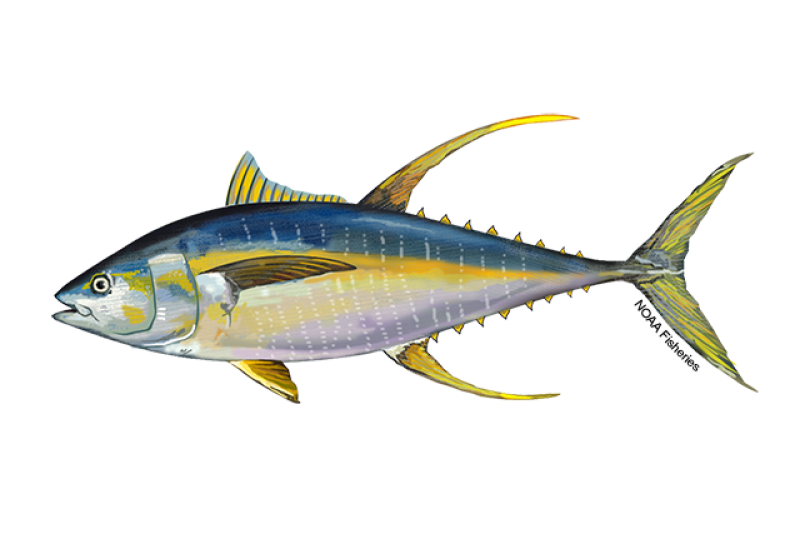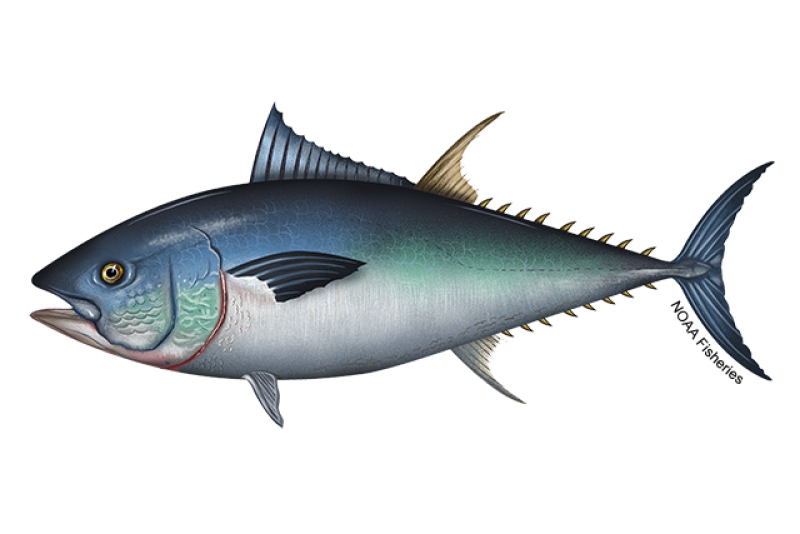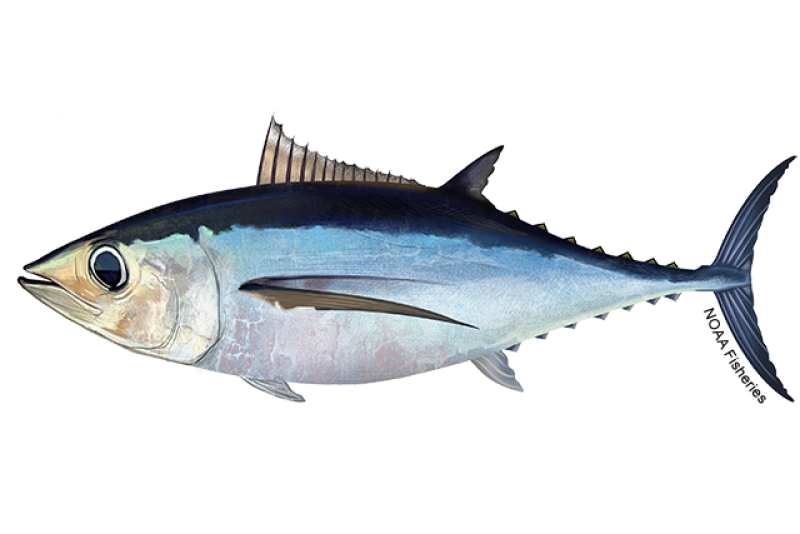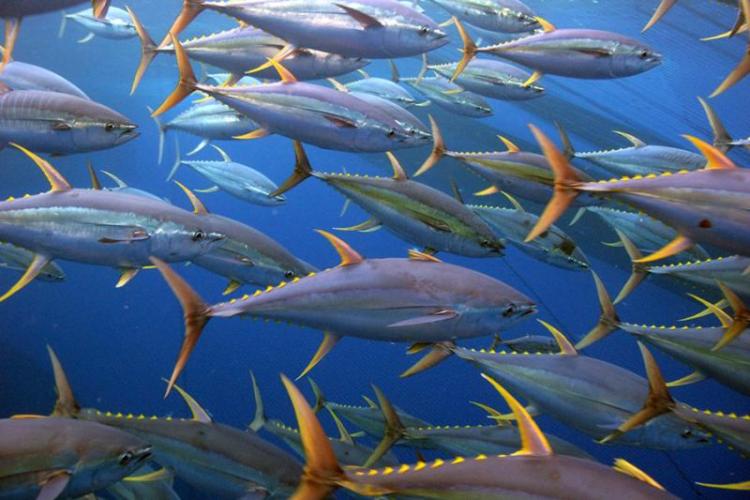 School of yellowfin tuna. Credit: Jeff Muir
School of yellowfin tuna. Credit: Jeff Muir
School of yellowfin tuna. Credit: Jeff Muir
About the Species
 School of yellowfin tuna. Credit: Jeff Muir
School of yellowfin tuna. Credit: Jeff Muir
School of yellowfin tuna. Credit: Jeff Muir
U.S. wild-caught Pacific yellowfin tuna is a smart seafood choice because it is sustainably managed and responsibly harvested under U.S. regulations.

Population
The stocks are not overfished.

Fishing Rate
Not subject to overfishing.

Habitat Impact
Fishing gear used to catch Pacific yellowfin tuna rarely contacts the seafloor so habitat impacts are minimal.

Bycatch
Regulations are in place to minimize bycatch.
Population Status
- There are two stocks of Pacific yellowfin tuna: The Eastern Pacific stock and the Central and Western Pacific stock. According to the most recent stock assessments:
- The Eastern Pacific stock is not overfished and not subject to overfishing (2023 stock assessment). Summary stock assessment information can be found on Stock SMART.
- The Central and Western Pacific stock is not overfished and is not subject to overfishing (2020 stock assessment). Summary stock assessment information can be found on Stock SMART.
Appearance
- Yellowfin tuna are torpedo-shaped.
- They are metallic dark blue on the back and upper sides and change from yellow to silver on the belly.
- True to their name, their dorsal and anal fins and finlets are bright yellow.
- An adult yellowfin tuna can be distinguished from other tunas by its long, bright-yellow dorsal fin and a yellow stripe down its side.
Biology
- Yellowfin tuna grow fast, up to 6 feet long and 400 pounds, and have a somewhat short life span of 6 to 7 years.
- Most yellowfin tuna are able to reproduce when they reach age 2.
- They spawn throughout the year in tropical waters and seasonally at higher latitudes.
- Their peak spawning periods are in spring and fall.
- Yellowfin are very productive. Females can spawn almost daily and release millions of eggs each time they spawn.
- Adult yellowfin tuna feed near the top of the food chain on fish, squid, and crustaceans.
- Fish, seabirds, dolphins, and other animals prey on larval and juvenile tuna.
- Marine mammals, billfish, and sharks feed on adult tuna.
Where They Live
Range
- Yellowfin tuna are found in tropical and subtropical oceans around the world, including the waters around the U.S. Pacific Islands and off southern California.
Habitat
- Yellowfin tuna are highly migratory and travel long distances throughout the warm ocean.
- They favor water temperatures between 64° and 88° F.
- They make annual trips to higher latitudes as water temperatures increase with the seasons.
- Larval and juvenile yellowfin tuna stay in surface waters, while older yellowfin tuna are often found in deeper water.
- Yellowfin tuna are known to gather around drifting flotsam (natural floating debris), fish aggregating devices (FADs), anchored buoys, dolphins, and other large marine animals.
- Adult yellowfin also gather in areas having abundant phytoplankton and zooplankton and smaller prey.
Fishery Management
- NOAA Fisheries and the Pacific Fishery Management Council manage the Pacific yellowfin tuna fishery on the West Coast.
- Managed under the Fishery Management Plan for U.S. West Coast Fisheries for Highly Migratory Species:
- Fishermen are required to have permits and to record their catch in logbooks.
- Gear restrictions and operational requirements are in place to minimize bycatch.
- Large purse seine vessels that fish for tuna in the eastern Pacific Ocean are required to have 100 percent observer coverage.
- All other commercial vessels based on the U.S. West Coast must carry a fishery observer, if requested by NOAA Fisheries.
- Longline fishing is prohibited within 200 miles of the U.S. West Coast.
- Annual training in safe handling and release techniques for protected species is required and all vessels must carry and use specific equipment for handling and releasing these animals.
- NOAA Fisheries and Western Pacific Fishery Management Council manage the Pacific yellowfin tuna fishery in the Pacific Islands.
- Managed under the Fishery Ecosystem Plan for the Pelagic Fisheries of the Western Pacific:
- Fishermen are required to have permits and to record catch in logbooks.
- Gear restrictions and monitoring requirements are in place to minimize bycatch and potential gear conflicts between different fisheries.
- A limit on the number of permits for Hawaii and American Samoa longline fisheries controls participation in the fishery.
- Longline fishing is prohibited in some areas to protect endangered Hawaiian monk seals, reduce conflicts between fishermen, and prevent localized stock depletion (when a large number of fish are removed from an area).
- These areas are enforced through NOAA Fisheries’ vessel monitoring system program (longline boats must be equipped with a satellite transponder that provides real-time position updates and tracks vessel movements).
- Hawaii-based and American Samoa–based longline vessels must carry onboard observers when requested by NOAA Fisheries, in part to record interactions with sea turtles, seabirds, and marine mammals.
- Annual training in safe handling and release techniques for protected species is required and all vessels must carry and use specific equipment for handling and releasing these animals.
- Management of highly migratory species, like Pacific yellowfin tuna, is complicated because the species migrate thousands of miles across international boundaries and are fished by many nations.
- Effective conservation and management of this resource requires international cooperation as well as strong domestic management.
- Two international organizations, the Inter-American Tropical Tuna Commission (IATTC) and the Western and Central Pacific Fisheries Commission (WCPFC), manage this fishery internationally. Working with the U.S. Department of State, NOAA Fisheries domestically implements the IATTC and WCPFC conservation and management measures.
- Under the South Pacific Tuna Treaty, U.S. purse seine vessels operating throughout the western and central Pacific Ocean must be registered and are monitored through logbooks, cannery landing receipts, national surveillance activities, observers, and port sampling.
- Purse seiners in the eastern Pacific Ocean also operate under the International Dolphin Conservation Program, a multilateral agreement aimed at reducing and minimizing bycatch of dolphins and undersize tuna.
- In 2000, the United States established the Dolphin-Safe Tuna Tracking and Verification Program to monitor the domestic production and importation of all frozen and processed tuna products nationwide and to authenticate any associated dolphin-safe claim.
Harvest
- Commercial fishery:
- U.S. harvest of yellowfin tuna in the Pacific Ocean makes up only a small percentage of the yellowfin tuna harvested worldwide.
- In 2023, commercial landings of Pacific yellowfin tuna totaled 7.8 million pounds and were valued at $30 million, according to the NOAA Fisheries commercial fishing landings database.
- Gear types, habitat impacts, and bycatch:
- Fishermen based in Hawaii, American Samoa, and the U.S. Pacific Islands target Pacific yellowfin tuna with hook-and-line, pelagic longline, or troll fishing gear.
- U.S. commercial purse seine fishermen in the western and central Pacific Ocean and the eastern Pacific Ocean also harvest yellowfin tuna.
- There is a small U.S. purse seine fleet operating in the eastern Pacific Ocean that sometimes targets Pacific yellowfin tuna when warm water from the south brings the species within their range.
- Fishing gear used to catch Pacific yellowfin tuna rarely contacts the seafloor so habitat impacts are minimal.
- Restrictions on the type of fishing gear that can be used and prohibitions on fishing in certain areas minimize impacts on protected species.
- Interactions with protected species such as sea turtles, marine mammals, and seabirds in these fisheries are rare and survival rates are estimated to be high for all gear types.
- Longline fishermen are trained in safe handling and release techniques for sea turtles, seabirds, and marine mammals, and they carry and use specific equipment for handling and releasing these animals.
- Scientists and managers continue to monitor bycatch in these fisheries through logbooks and fishery observer programs.
- Management measures are in place to minimize bycatch of juvenile Pacific yellowfin tuna.
- Recreational fishery:
- In 2023, recreational anglers landed 21 million pounds of Pacific yellowfin tuna, according to the NOAA Fisheries recreational fishing landings database.
- Recreational anglers fish for yellowfin tuna with troll, rod-and-reel, and handline gear and sometimes by free-diving with spear guns.
- Off California, anglers must be licensed and daily bag limits are in place. Recreational charter boats must keep logbooks of their catch.
- There are no federal regulations for recreational fishing off Hawaii and U.S. Pacific Island territories, but local rules may apply.
Scientific Classification
- Yellowfin tuna are found in tropical and subtropical oceans around the world, including the waters around the U.S. Pacific Islands and off southern California.
- Yellowfin tuna are highly migratory and travel long distances throughout the warm ocean.
- They favor water temperatures between 64° and 88° F.
- They make annual trips to higher latitudes as water temperatures increase with the seasons.
- Larval and juvenile yellowfin tuna stay in surface waters, while older yellowfin tuna are often found in deeper water.
- Yellowfin tuna are known to gather around drifting flotsam (natural floating debris), fish aggregating devices (FADs), anchored buoys, dolphins, and other large marine animals.
- Adult yellowfin also gather in areas having abundant phytoplankton and zooplankton and smaller prey.
Fishery Management
- NOAA Fisheries and the Pacific Fishery Management Council manage the Pacific yellowfin tuna fishery on the West Coast.
- Managed under the Fishery Management Plan for U.S. West Coast Fisheries for Highly Migratory Species:
- Fishermen are required to have permits and to record their catch in logbooks.
- Gear restrictions and operational requirements are in place to minimize bycatch.
- Large purse seine vessels that fish for tuna in the eastern Pacific Ocean are required to have 100 percent observer coverage.
- All other commercial vessels based on the U.S. West Coast must carry a fishery observer, if requested by NOAA Fisheries.
- Longline fishing is prohibited within 200 miles of the U.S. West Coast.
- Annual training in safe handling and release techniques for protected species is required and all vessels must carry and use specific equipment for handling and releasing these animals.
- NOAA Fisheries and Western Pacific Fishery Management Council manage the Pacific yellowfin tuna fishery in the Pacific Islands.
- Managed under the Fishery Ecosystem Plan for the Pelagic Fisheries of the Western Pacific:
- Fishermen are required to have permits and to record catch in logbooks.
- Gear restrictions and monitoring requirements are in place to minimize bycatch and potential gear conflicts between different fisheries.
- A limit on the number of permits for Hawaii and American Samoa longline fisheries controls participation in the fishery.
- Longline fishing is prohibited in some areas to protect endangered Hawaiian monk seals, reduce conflicts between fishermen, and prevent localized stock depletion (when a large number of fish are removed from an area).
- These areas are enforced through NOAA Fisheries’ vessel monitoring system program (longline boats must be equipped with a satellite transponder that provides real-time position updates and tracks vessel movements).
- Hawaii-based and American Samoa–based longline vessels must carry onboard observers when requested by NOAA Fisheries, in part to record interactions with sea turtles, seabirds, and marine mammals.
- Annual training in safe handling and release techniques for protected species is required and all vessels must carry and use specific equipment for handling and releasing these animals.
- Management of highly migratory species, like Pacific yellowfin tuna, is complicated because the species migrate thousands of miles across international boundaries and are fished by many nations.
- Effective conservation and management of this resource requires international cooperation as well as strong domestic management.
- Two international organizations, the Inter-American Tropical Tuna Commission (IATTC) and the Western and Central Pacific Fisheries Commission (WCPFC), manage this fishery internationally. Working with the U.S. Department of State, NOAA Fisheries domestically implements the IATTC and WCPFC conservation and management measures.
- Under the South Pacific Tuna Treaty, U.S. purse seine vessels operating throughout the western and central Pacific Ocean must be registered and are monitored through logbooks, cannery landing receipts, national surveillance activities, observers, and port sampling.
- Purse seiners in the eastern Pacific Ocean also operate under the International Dolphin Conservation Program, a multilateral agreement aimed at reducing and minimizing bycatch of dolphins and undersize tuna.
- In 2000, the United States established the Dolphin-Safe Tuna Tracking and Verification Program to monitor the domestic production and importation of all frozen and processed tuna products nationwide and to authenticate any associated dolphin-safe claim.
Harvest
- Commercial fishery:
- U.S. harvest of yellowfin tuna in the Pacific Ocean makes up only a small percentage of the yellowfin tuna harvested worldwide.
- In 2023, commercial landings of Pacific yellowfin tuna totaled 7.8 million pounds and were valued at $30 million, according to the NOAA Fisheries commercial fishing landings database.
- Gear types, habitat impacts, and bycatch:
- Fishermen based in Hawaii, American Samoa, and the U.S. Pacific Islands target Pacific yellowfin tuna with hook-and-line, pelagic longline, or troll fishing gear.
- U.S. commercial purse seine fishermen in the western and central Pacific Ocean and the eastern Pacific Ocean also harvest yellowfin tuna.
- There is a small U.S. purse seine fleet operating in the eastern Pacific Ocean that sometimes targets Pacific yellowfin tuna when warm water from the south brings the species within their range.
- Fishing gear used to catch Pacific yellowfin tuna rarely contacts the seafloor so habitat impacts are minimal.
- Restrictions on the type of fishing gear that can be used and prohibitions on fishing in certain areas minimize impacts on protected species.
- Interactions with protected species such as sea turtles, marine mammals, and seabirds in these fisheries are rare and survival rates are estimated to be high for all gear types.
- Longline fishermen are trained in safe handling and release techniques for sea turtles, seabirds, and marine mammals, and they carry and use specific equipment for handling and releasing these animals.
- Scientists and managers continue to monitor bycatch in these fisheries through logbooks and fishery observer programs.
- Management measures are in place to minimize bycatch of juvenile Pacific yellowfin tuna.
- Recreational fishery:
- In 2023, recreational anglers landed 21 million pounds of Pacific yellowfin tuna, according to the NOAA Fisheries recreational fishing landings database.
- Recreational anglers fish for yellowfin tuna with troll, rod-and-reel, and handline gear and sometimes by free-diving with spear guns.
- Off California, anglers must be licensed and daily bag limits are in place. Recreational charter boats must keep logbooks of their catch.
- There are no federal regulations for recreational fishing off Hawaii and U.S. Pacific Island territories, but local rules may apply.
Scientific Classification
| Kingdom | Animalia | Phylum | Chordata | Class | Actinopterygii | Order | Scombriformes | Family | Scombridae | Genus | Thunnus | Species | albacares |
|---|
Last updated by NOAA Fisheries on 04/03/2025
Featured News
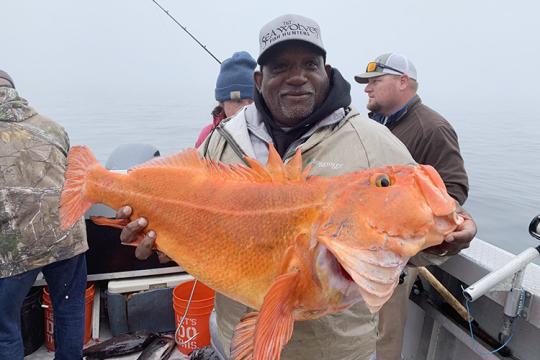
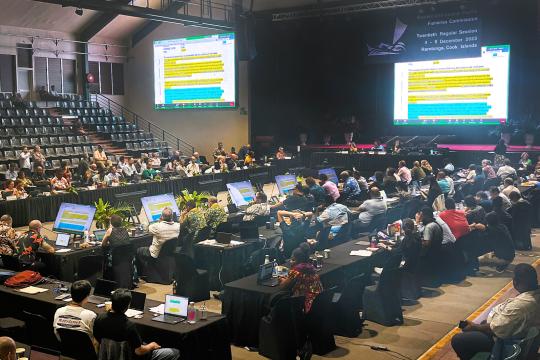 The 20th Annual Western and Central Pacific Fisheries Commission meeting at the Te Are Kariori (National Auditorium) in
Rarotonga, Cook Islands. Credit: NOAA Fisheries.
The 20th Annual Western and Central Pacific Fisheries Commission meeting at the Te Are Kariori (National Auditorium) in
Rarotonga, Cook Islands. Credit: NOAA Fisheries.
 A bidder checks the quality of tuna at the Honolulu Fish Auction. Credit: NOAA Fisheries
A bidder checks the quality of tuna at the Honolulu Fish Auction. Credit: NOAA Fisheries
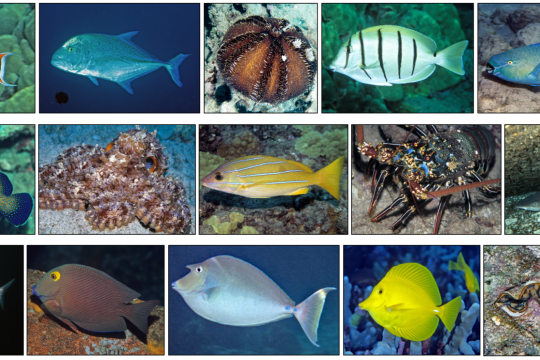 Fifteen of the 83 species included in the Pacific Islands vulnerability assessment. From left to right: Acanthurus achilles, Caranx melampygus, Tripneustes gratilla, Acanthurus triostegus, Scarus rubroviolaceus, Cephalopholis argus, Octopus cyanea, Lutjanus kasmira, Panulirus penicillatus, Triaenodon obesus, Selar crumenophthalmus, Ctenochaetus strigosus, Naso unicornis, Zebrasoma flavescens, Tridacna maxima. Photo credit: Bruce Mundy.
Fifteen of the 83 species included in the Pacific Islands vulnerability assessment. From left to right: Acanthurus achilles, Caranx melampygus, Tripneustes gratilla, Acanthurus triostegus, Scarus rubroviolaceus, Cephalopholis argus, Octopus cyanea, Lutjanus kasmira, Panulirus penicillatus, Triaenodon obesus, Selar crumenophthalmus, Ctenochaetus strigosus, Naso unicornis, Zebrasoma flavescens, Tridacna maxima. Photo credit: Bruce Mundy.
Seafood Facts

Is Pacific Yellowfin Tuna Sustainable?
U.S. wild-caught Pacific yellowfin tuna is a smart seafood choice because it is sustainably managed and responsibly harvested under U.S. regulations.
Availability
Year-round.
Source
U.S. wild-caught from Hawaii, California, U.S. Pacific Island territories, and the high seas.
Taste
Yellowfin tuna has a mild, meaty flavor. It’s more flavorful than albacore, but leaner than bluefin.
Texture
The meat is firm and moist, with large flakes.
Color
Meat is bright red when raw and turns brown to grayish-tan when cooked.
Health Benefits
Yellowfin tuna is low in saturated fat and sodium and is a very good source of protein, thiamin, selenium, vitamin B6, and omega-3s.
Nutrition Facts
Servings: 1; Serving Weight: 100 g (raw); Calories: 108; Protein: 23.38 g; Total Fat: 0.95 g; Total Saturated Fatty Acids: 0.235 g; Carbohydrate: 0 g; Total Sugars: 0 g; Total Dietary Fiber: 0 g; Cholesterol: 45 mg; Selenium: 36.5 mcg; Sodium: 37 mgMore Information
Yellowfin Tuna Recipes
There are many ways to cook tuna based on cut and species. For cooking inspiration, browse these recipes for baked tuna with fresh basil, herb broiled yellowfin, and more!

Last updated by NOAA Fisheries on 04/03/2025
Seafood News
 Celebrate Culinary Arts Month with a sustainable seafood recipe for every month of the year.
Celebrate Culinary Arts Month with a sustainable seafood recipe for every month of the year.
What Your Birth Month Says About Your Next Seafood Recipe
 Fresh-caught taʻape on ice. Credit: Conservation International Hawaiʻi.
Fresh-caught taʻape on ice. Credit: Conservation International Hawaiʻi.
Reducing Waste and Feeding Communities in Hawaiʻi with a Whole Fish Approach
 Chef Tyler Hadfield’s Curried Skate Wings with Tomato-Masala Chutney
Chef Tyler Hadfield’s Curried Skate Wings with Tomato-Masala Chutney
Ring In the New Year With These Crowd-Favorite Seafood Recipes
 NOAA Fisheries, in collaboration with Blue Ocean Mariculture, is conducting a multi-year pilot study to evaluate observational methods and tools for studying Hawaiian monk seal behavior. Courtesy of Blue Ocean Mariculture
NOAA Fisheries, in collaboration with Blue Ocean Mariculture, is conducting a multi-year pilot study to evaluate observational methods and tools for studying Hawaiian monk seal behavior. Courtesy of Blue Ocean Mariculture
AI Meets Aquaculture to Study Hawaiian Monk Seal Interactions With Net Pens
Documents
Vessel Level Annual Cost-Earnings Study of the Hawaii Offshore Handline Fishery and the Hawaii Small Boat Commercial Fishery, 2014
This study examines the economic performance of the offshore handline fishery and the Hawaii small…
Data & Maps
American Samoa Longline Logbook Reports 2023
Logbook summary reports for the 2023 calendar year.
American Samoa Longline Logbook Reports 2022
Logbook summary reports for the 2022 calendar year.
Hawaii and California Longline Logbook Reports 2022
Logbook summary reports for the 2022 calendar year.
Hawaii and California Longline Logbook Reports 2021
Logbook summary reports for the 2021 calendar year.
Research
Hedonic Price Model of Hawaiʻi ʻAhi Tuna (Thunnus obesus and Thunnus albacares) Market: Implications of Climate Change and Shark Depredation
Using a hedonic price model to estimate tuna price using fish characteristics, trip-specific…
Influence of El Niño-Southern Oscillation on Bigeye and Yellowfin Tuna Longline Catch per Unit Effort in the Equatorial Pacific
In this study, we investigate the statistical relationships between past ENSO conditions and…
Fishery Monitoring for West Coast and International Fisheries
We transform fisheries data into fisheries information via summations and statistical analyses to support stock assessments, scientific studies, and national and international data reporting requirements.
Complex Dispersal of Adult Yellowfin Tuna From the Main Hawaiian Islands
Local availability of yellowfin tuna is a key economic, dietary and cultural concern for MHI…
Last updated by NOAA Fisheries on 04/03/2025
